Pruning Techniques
Keep Your Garden Thriving with Proper Pruning Techniques
Having a well-maintained garden not only enhances the beauty of your outdoor space but also promotes the health of your plants. One essential practice that can help your garden thrive is proper pruning. Pruning involves selectively removing parts of a plant to improve its structure, health, and appearance. Here are some tips and techniques to ensure you prune your garden effectively.
1. Understand the Purpose of Pruning
Before you start pruning, it's crucial to understand why you are doing it. Pruning can serve several purposes, such as removing dead or diseased branches, shaping the plant, promoting growth, and controlling size. By knowing the goal of your pruning, you can make more informed decisions.
2. Use the Right Tools
Having the proper tools for pruning is essential to make clean cuts without damaging the plant. Some common tools for pruning include pruning shears, loppers, and pruning saws. Make sure your tools are sharp and clean to prevent tearing or crushing the plant tissue.
3. Know When to Prune
Each plant has its optimal time for pruning to encourage healthy growth. While some plants benefit from pruning in the dormant season, others should be pruned after flowering. Research the specific needs of your plants to determine the best time for pruning.
4. Identify What to Prune
When deciding what to prune, look for dead, damaged, or diseased branches first. Additionally, you can prune to shape the plant, remove crossing branches, or improve airflow within the canopy. Avoid over-pruning, as it can stress the plant.
5. Make Clean Cuts
When pruning, make your cuts at a 45-degree angle just above a bud or branch collar. This angle helps promote healing and prevents water from accumulating on the cut surface. Avoid leaving stubs, as they can invite diseases into the plant.
6. Monitor Plant Health
After pruning, keep an eye on your plants to ensure they are responding well. Watch for signs of stress, such as wilting or discoloration, and adjust your pruning techniques if needed. Proper pruning should encourage healthy regrowth.
Conclusion
Pruning is a valuable skill that can benefit your garden in numerous ways. By understanding the purpose of pruning, using the right tools, knowing when and what to prune, making clean cuts, and monitoring plant health, you can keep your garden thriving throughout the year. Remember to approach pruning with care and patience to ensure the best results for your plants.

For more information on gardening tips and techniques, visit Gardeners World.
